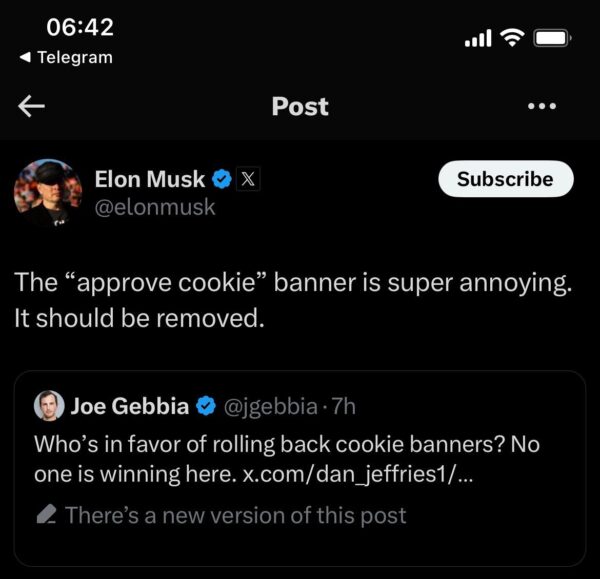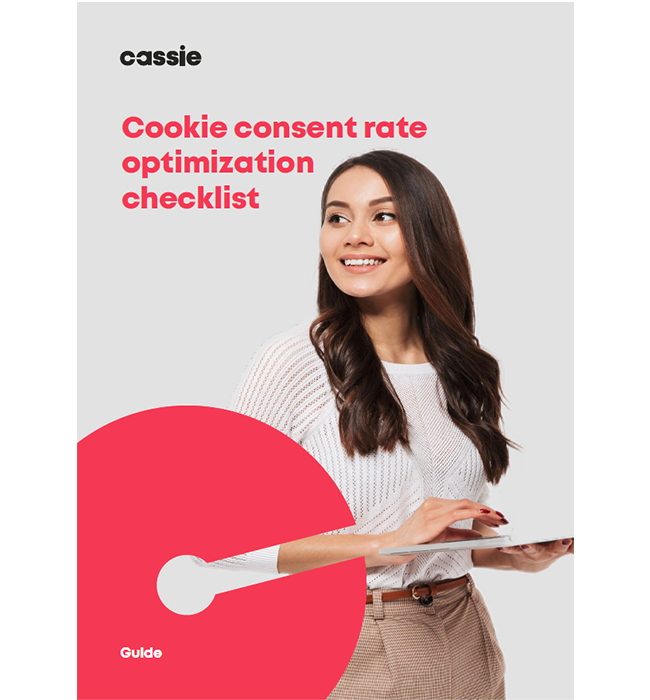Elon Musk doesn’t like cookie banners... But are they the problem?
Posted: November 19, 2024
An interesting article on cookie banners saw some viral traction this week with Airbnb founder, Joe Gebbia, and new co-chair of the US Government Department of Efficiency, Elon Musk, weighing in.
Both commented their disapproval of cookie banners – Gebbia tweeted: “Who’s in favour of rolling back cookie banners? No one is winning here.”
Musk added, “The “approve cookie” banner is super annoying. It should be removed.”
As of writing, Musk’s tweet has 15.5 million views, 3,740 reposts, 532 quotes and 56.2K likes.

The article highlights a recent study that found Europeans spend 575 Million hours per year clicking cookie banners. For each individual user, that’s roughly 1.42 hours per year of time.
Which of course, sounds like a lot of time that could be better used.
But are the cookie banners the bad guys?
Or is it the brands behind them not quite getting the balance right for the user experience? Are they just seeing cookie compliance and consent as a box-ticking exercise?
Some cookie banner background…
For web users in the EU, cookie banners have become widely used, and to an extent, accepted, as part of the digital experience when visiting websites and more recently, apps.
This is after the introduction of the European General Data Protection Regulation (GDPR), mandating that websites need to inform users about how and why they collect personal data.
There’s often debate around whether people really know what they’re consenting to and whether they click accept or reject just to get rid of the banner. Many studies have been done but there’s often variable findings.
The average cookie consent rate is 31%, but it can range from 4% to 85%.
A more recent survey found that whilst in 2018, 76% of users ignored cookie banners, by 2023, that number had decreased to 33.6%. This could be due to increased awareness of data protection and cookie usage, with many websites forcing users to interact with the banner before being able to access the site.
Either way, the sentiment around cookie banners is mixed.
But this could be in part due to the way that some websites choose to display banners – intrusive styling, dark patterns and forced opt ins, for example – versus websites that aim to put transparency first, with granular options and clear explanations for what cookies mean and how they plan to use the data collected.
How do consumers feel about cookie banners?
Cassie carried out a recent study of consumers around the world that found 95% of people wish companies were more transparent about their data collection and sharing practices. Further to this, consent fatigue is high: 73% feel overwhelmed by the number of consent requests when using online services.
The impacts of consent fatigue can also have ramifications on how people interact with the banner, with many going against their gut feelings – with 67% consenting to cookies to view a website, even though they felt skeptical.
This lack of trust can also have serious financial consequences. 59% of consumers prioritize their online data privacy above all else and are willing to forego certain online experiences to maintain it. If you fail to foster trust and transparency, you risk losing customers to competitors that do.
Cookie banners in the US
Whilst cookie banners aren’t as common in the US as they are in the EU, evolving state-specific legislation is driving awareness and change, alongside many companies that operate globally opting to display banners in line with GDPR even when they don’t need to.
This is part of the difficulties that enterprise-level organizations face when trying to navigate which legislation to follow, with the risk of fines extremely high due to the sheer scale and complexity of data being collected.
Prioritizing trust and transparency
Transparency is a cornerstone of building trust between brands and consumers. When brands are clear about their data collection practices, they demonstrate respect for their users’ privacy.
This transparency can foster loyalty and long-term relationships. In an era where data breaches and privacy concerns are rampant, being upfront about how data is used can set a brand apart from its competitors.
At the heart of this issue is the consumer. Brands must remember that the ultimate goal is to create a positive experience for their users. By prioritizing transparency and trust, they can build stronger relationships and foster loyalty. In a world where data privacy is increasingly important, brands that get this right will stand out and succeed.
Consent: More than just a box-ticking exercise
Of course, we’re biased, as Cassie is a consent and preference management platform. So you could say we have a vested interest in cookie banners sticking around!
But fundamentally, the purpose of cookie banners is to protect end users’ choices regarding how their data is stored and used. This, of course, has a huge impact on how businesses can utilize the data they collect.
Without consent, you can’t communicate or engage with your customers.
Without cookie banners, you can’t understand user behavior on your website to inform user improvements or drive personalized experiences. These are positive results for both you and the user, but you have to make the consent experience simple and easy to process.
Cassie has specific out-of-the-box functionality designed to make consent mechanisms work smarter, reduce consent fatigue, and create more seamless transitions.
Identity Service
As first-party data becomes more paramount, our cookie module is the only solution on the market that enables you to compliantly keep cookies alive when browsers like Safari/ITP delete them. As Google and Chrome look to be moving to a similar solution, this problem will increase. The Cassie Identity Service regenerates the cookie of returning visitors, which means you can improve attribution reporting by up to 35% and deliver personalized experiences based on individual user journeys.
Cross-Domain Consent
With Cassie’s Cross-Domain Consent you can ask anonymous website visitors to provide cookie preferences once and then share consent across multiple brand domains to improve the user experience and reduce consent fatigue. Other CMPs can only do this at subdomain level and struggle to match and connect at device level. This essentially means that you’ll display the cookie banner once, and then store their choices across different websites so that it won’t repeatedly show again.
Follow Me Consent
Cassie manages consent throughout the user journey (from anonymous to known contacts) – honoring consent across multiple domains and devices. Our unique ‘follow me consent’ solution avoids interruptions of intrusive cookies whilst honoring choices to remain compliant. This can support specific legislative requirements like Global Privacy Controls and Universal Opt Out Mechanisms, as well as ensure that once a user gives their consent preferences, they’re honored everywhere.
Final thoughts…
The debate around cookie banners is far from over. While Elon Musk’s frustrations resonate with many, it’s essential to consider the broader implications of these banners. They are not merely nuisances but tools designed to protect user privacy and ensure transparency in data collection practices.
The challenge lies in finding a balance that respects user experience while maintaining compliance with regulations like GDPR. Brands must move beyond viewing cookie consent as a box-ticking exercise and instead focus on creating clear, user-friendly consent mechanisms. By prioritizing transparency and trust, companies can foster stronger relationships with their users, ultimately benefiting both parties.
As technology continues to evolve, so must our data privacy approach. Innovations in consent management show promise in reducing consent fatigue and improving user experience. The future of cookie banners may well depend on such advancements, ensuring they serve their intended purpose without becoming a burden.
In the end, the goal should be to create a digital environment where users feel informed and respected, and where their data is handled with the utmost care. Only then can we hope to see a shift in the sentiment surrounding cookie banners, transforming them from a source of frustration to a symbol of trust and transparency.

Cookie Consent Checklist: 20+ Points to Consider
Do you actively monitor the performance of your cookie banners or regularly make changes to enhance engagement? Cookie banner optimization is essential to increase user engagement and build trust. This free guide covers 20+ cookie banner optimization points to consider that meet regulatory guidelines and improve higher opt-in rates, so that your business can achieve compliance without compromise.

